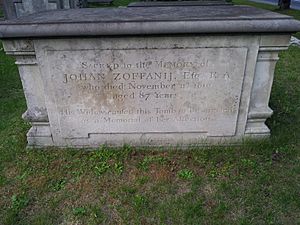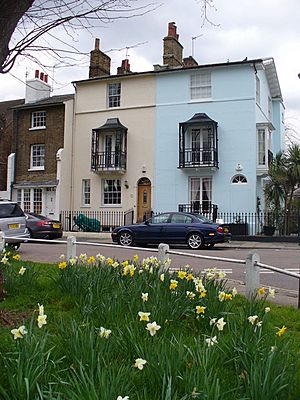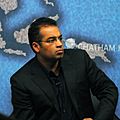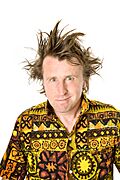Kew facts for kids
Quick facts for kids Kew |
|
|---|---|
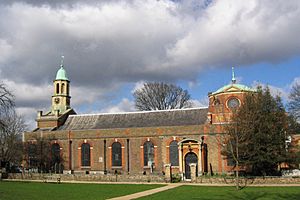 Parish Church of St Anne |
|
 Temperate House in Kew Gardens |
|
| Area | 3.30 km2 (1.27 sq mi) |
| Population | 11,436 2011 Census (Kew ward 2011) |
| • Density | 3,465/km2 (8,970/sq mi) |
| OS grid reference | TQ195775 |
| London borough | |
| Ceremonial county | Greater London |
| Region | |
| Country | England |
| Sovereign state | United Kingdom |
| Post town | RICHMOND |
| Postcode district | TW9 |
| Dialling code | 020 |
| Police | Metropolitan |
| Fire | London |
| Ambulance | London |
| EU Parliament | London |
| UK Parliament |
|
| London Assembly |
|
Kew (pronounced "kyoo") is a lovely area in the London Borough of Richmond upon Thames. In 2011, about 11,436 people lived here. Kew is famous for the Royal Botanic Gardens, which is a World Heritage Site. This means it's a very special place recognized around the world! Inside Kew Gardens, you can also find Kew Palace.
Kew is also home to important historical papers, like the famous Domesday Book. These are kept safe at The National Archives.
Long ago, in 54 BC, the Roman leader Julius Caesar might have crossed the Thames river right here in Kew. Many kings and queens from the Tudor, Stuart, and Georgian times had connections to Kew. During the French Revolution, many people seeking safety came to live here. Also, many artists lived in Kew in the 1700s and 1800s.
Since 1965, Kew has included the area of North Sheen. This part is home to St Philip and All Saints, which was the first "barn church" in England.
Today, Kew is a popular place to live. It has many parks, good schools, and easy ways to travel around. You'll find nice architecture, restaurants, and lots of trees and gardens. Most of Kew grew in the late 1800s when the District line of the London Underground arrived. More homes were built in the 1920s and 1930s, and even more recently, new apartments and houses were built by the River Thames.
Contents
What's in a Name?

The name Kew was first written down in 1327 as Cayho. It comes from two old words. Kai is an Old French word meaning "landing place" or "quay". Hoh is an Old English word for a "spur of land." This "spur of land" is the bend in the Thames river where Kew is located.
How Kew is Governed
Kew is part of the Richmond Park area for the UK Parliament. The Member of Parliament (MP) for this area is Sarah Olney from the Liberal Democrats party. For the London Assembly, Kew is part of the South West London Assembly constituency. This area is represented by Nicholas Rogers from the Conservative Party.
Kew became part of the Municipal Borough of Richmond in 1892. This borough was in the county of Surrey. In 1965, a new law changed things. Kew, along with Richmond, became part of the London Borough of Richmond upon Thames. This is one of the 32 boroughs in the new Greater London area.
Kew's Economy and Businesses
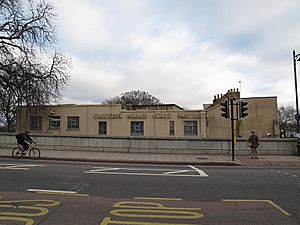
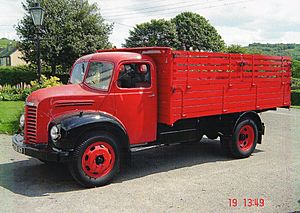
The fashion company Jigsaw used to have its main office in Kew.
One interesting old industry in Kew was making nameplates. The Caxton Name Plate Manufacturing Company was based on Kew Green. It started in 1964 but closed in 1997.
Did you know that rayon (a type of fabric) was first developed in Kew? It happened in a lab near Kew Gardens station. A factory on South Avenue then produced rayon before another company bought the patents in 1904.
Also, near Kew Gardens station, an engineering company called F C Blake made petrol-powered traction engines (like old-fashioned tractors) in the late 1800s and early 1900s. A street in Kew, Blake Mews, is named after this company.
Cars and Lorries Made in Kew
Today, Kew Retail Park stands where an aircraft factory used to be. This factory was built in 1918 and made planes for the British government during the First World War.
In 1923, the aircraft factory was sold and became a place for making road vehicles. From the 1920s until 1967, Dodge made lorries (trucks) at this factory. They even had a model called the Dodge Kew! Cars were also made there.
During the Second World War, this factory helped build parts for Handley Page Halifax aircraft. After the war, it stopped making North American cars.
Famous People from Kew
Many interesting people have lived in Kew, including artists, scientists, and even royalty!
Royal Connections to Kew
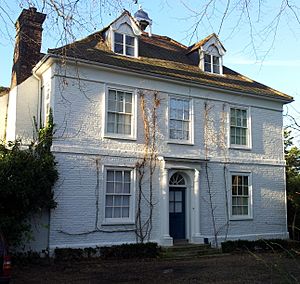
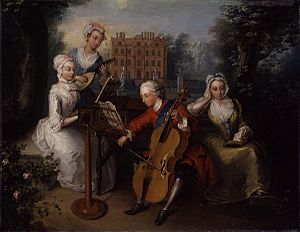
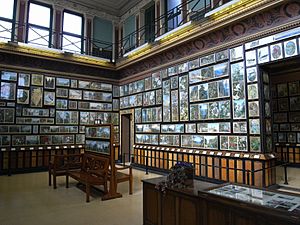
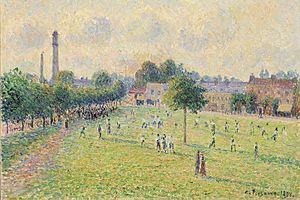
Tudor and Stuart Times
Charles Somerset, 1st Earl of Worcester was given land in Kew in 1517. Later, Thomas Cromwell and Charles Brandon, 1st Duke of Suffolk owned a large house here. Mary Tudor, Queen of France, the daughter of King Henry VII, also stayed in Kew.
Henry Norris, a close friend of King Henry VIII, lived at Kew Farm. This farm was later owned by Robert Dudley, Earl of Leicester, who was a favorite of Queen Elizabeth I. This grand house was on the riverbank.
Many houses were built along Kew Green during Elizabeth I's reign and under the Stuart kings. West Hall, which you can still see today, dates back to at least the 1300s.
Elizabeth Stuart, daughter of King James I, lived in Kew in 1608.
Queen Anne helped pay for the building of the parish church on Kew Green. It was named after Saint Anne in 1714, just before the queen died.
Hanoverian Royals
The Hanoverian royal family had the strongest ties to Kew. Princess Augusta of Saxe-Gotha started the botanic gardens. Her husband, Frederick, Prince of Wales, lived at the White House in Kew. Princess Augusta continued to live there until she died in 1772. Frederick also ordered the first large greenhouse to be built at Kew Gardens.
In 1772, King George III and Queen Charlotte moved into the White House. Queen Charlotte later died at the Dutch House (Kew Palace) in 1818.
King William IV spent much of his early life in Kew Palace, where he was taught by private teachers.
Artists Connected to Kew
In the 1760s and 1770s, the presence of the royal family attracted artists like Thomas Gainsborough and Johan Zoffany to Kew.
- Franz Bauer (1758–1840) was an Austrian artist who became the first botanical illustrator at Kew Gardens. He taught Queen Charlotte and her daughter how to draw plants. He is buried at St Anne's Church.
- Thomas Gainsborough (1727–1788), a very important British artist, visited Kew many times. He stayed with his friend Joshua Kirby and later near St Anne's Church, where he is buried.
- Arthur Hughes (1832–1915), a Pre-Raphaelite painter, lived and died at 22 Kew Green. A blue plaque marks his home.
- Joshua Kirby (1716–1774) was a landscape painter and writer. He moved to Kew in 1760 and taught linear perspective (how to draw things to look 3D) to King George III.
- Victorian artist Marianne North (1830–1890) didn't live in Kew, but she gave her amazing collection of plant art to Kew Gardens. She also paid for a special gallery, the Marianne North Gallery, to display them.
- French Impressionist painter Camille Pissarro (1830–1903) stayed at 10 Kew Green in 1892. He painted several famous scenes of Kew, including Kew Gardens – Path to the Great Glasshouse.
Botanists Who Lived in Kew
It's no surprise that many plant scientists (botanists) have lived in Kew, close to the famous botanic gardens!
- William Aiton (1731–1793) was the first director of the new botanical garden at Kew in 1759. He made many improvements and wrote a book about the plants there. His son, William Townsend Aiton (1766–1849), also a botanist, took over as director. Both father and son lived on Kew Green and are buried at St Anne's Church.
- Sir William Hooker (1785–1865) and his son Sir Joseph Hooker (1817–1911) were both botanists and directors of Kew Gardens. They lived at 49 Kew Green, marked by a blue plaque.
- John Smith (1798–1888) was the first curator (manager) at Kew Gardens. He lived on Kew Green and is buried at St Anne's Church.
Other Notable People

Many other interesting people have called Kew home:
- Harold Pinter (1930–2008), a famous playwright and Nobel Prize winner, lived in Kew.
- Patrick Troughton (1921–1987), an actor best known for playing the Second Doctor in Doctor Who, lived in Kew.
- Andrew Watson (1856–1921), the first black person to play international football, retired to London and died in Kew.
- Today, people like journalist Krishnan Guru-Murthy, comedian Milton Jones, and TV presenter Gabby Logan live in Kew.
Kew's Population and Homes
From 2001 to 2011, Kew's population grew from 9,445 to 11,436. This was the biggest increase in Kew in many years. It happened partly because old industrial land was turned into homes.
Types of Homes in Kew (2011 Census)
| Ward | Detached | Semi-detached | Terraced | Flats and apartments | Caravans/temporary/ mobile homes/houseboats |
Shared between households |
|---|---|---|---|---|---|---|
| Kew | 426 | 1,029 | 1,212 | 2,268 | 4 | 25 |
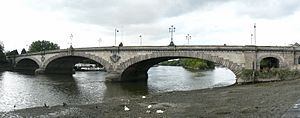
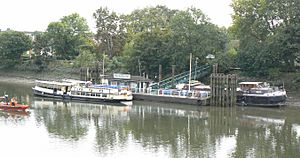
| Ward | Population | Households | % Owned outright | % Owned with a loan | Hectares |
|---|---|---|---|---|---|
| Kew | 11,436 | 4,941 | 30 | 30 | 330 |
Different Backgrounds in Kew
In the 2011 census, 66.2% of people in Kew were White British. The next largest group was "Other White" at 16%, and 8.1% were Asian.
Getting Around Kew
In the past, a main way to travel between Kew and London was by boat along the Thames. Kew was also connected to Brentford by a ferry. The first bridge was built in 1759. The current Kew Bridge, which carries the South Circular Road, was opened by King Edward VII and Queen Alexandra in 1903.
Kew Road (A307) is the main road link to Richmond. The M4 motorway starts close to Kew, making it easy to get to Heathrow Airport and other places to the west.
Since 1869, you can travel by train from Kew Gardens station. London Underground (District line) trains go to Richmond and central London. London Overground trains go to Richmond and Stratford.
Local bus routes like the 65, 110, and R68 serve Kew.
You can also take a river boat from Kew Pier to places like Westminster Millennium Pier, Richmond, and Hampton Court.
- Nearby Places
- Nearest Train Stations
- Kew Bridge station (South Western Railway)
- Kew Gardens station (London Overground; London Underground District line)
- North Sheen station (South Western Railway)
- Bridges in Kew
- Kew Bridge, which carries the A205 South Circular Road.
- Kew Railway Bridge
Parks and Green Spaces
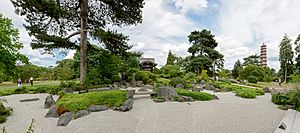
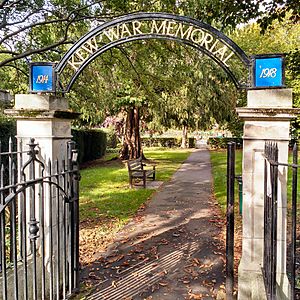
- Kew Green is a large open space where Kew Cricket Club plays cricket in the summer.
- Kew Pond, near Kew Green, is very old and helps local wildlife.
- North Sheen Recreation Ground, also called "The Rec," has football pitches, a running track, playgrounds, and a paddling pool. It opened in 1909.
- Pensford Field is now a nature reserve and home to Pensford Tennis Club.
- St Luke's Open Space is a quiet sitting area and playground.
- Westerley Ware is a memorial garden at Kew Bridge, with tennis courts and a playground.
Sports and Fun in Kew
Kew has several sports clubs:
- North Sheen Bowling Club
- Priory Park Club (tennis)
- Putney Town Rowing Club
- Richmond Gymnastics Association
The closest top-tier football club is Brentford FC, whose stadium is just across Kew Bridge.
Local Societies
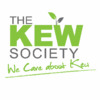 |
|
| Formation | 1901 (as the Kew Union) |
|---|---|
| Legal status | registered charity |
|
Membership
|
800 |
|
Chair
|
Shiona Williams |
|
Main organ
|
The Kew Society Newsletter |
|
Budget
|
£32,848 |
|
Staff
|
none |
The Kew Horticultural Society, started in 1938, holds an annual show and other events about gardening.
The Kew Society, founded in 1901, works to keep Kew beautiful and protect its history. They check all building plans to make sure they fit with the area's look. They also organize community events and publish a newsletter.
The Richmond Local History Society also studies the history of Kew.
Schools in Kew
Primary Schools
- Darell Primary and Nursery School opened in 1906. It's the only primary school in Richmond borough still in its original building from before 1914.
- Kew Riverside Primary School, on Courtlands Avenue, opened in 2003.
- The King’s Church of England Primary School moved to Cumberland Road in 1969. This school has a long history, dating back to 1719 when Lady Capel left money in her will to start a school in Kew. King George III and Queen Victoria also supported it.
Independent Preparatory Schools
- Broomfield House School was founded in 1876.
- Kew College is a school for children aged 3 to 11. It was started in 1927 by Mrs Ellen Upton.
- Kew Green Preparatory School opened in 2004.
- Unicorn School, started in 1970, is a school owned by parents, located opposite Kew Gardens.
Places of Worship
Kew has four churches that are currently in use:
| Name | Type of Church | History | Address | Website | Image |
|---|---|---|---|---|---|
| Our Lady of Loreto and St Winefride's, Kew | Roman Catholic | This church opened in 1906. It has been extended and updated over the years. It was officially dedicated in 1979 after a generous gift paid off its debts. | 1 Leyborne Park, Kew, Richmond TW9 3HB |  |
|
| St Anne's Church, Kew | Anglican | Built in 1714 on land given by Queen Anne, this church is now a Grade II* listed building, meaning it's very important. It has been extended many times. The churchyard has famous tombs, including those of artists Johan Zoffany and Thomas Gainsborough. | Kew Green, Kew, Richmond TW9 3AA |  |
|
| St Luke's Church, Kew | Anglican | Founded in 1889, St Luke's now shares a parish with the Barn Church. The church building was redesigned in 1983 to create a smaller worship area and to allow other parts to be used for community activities. It now hosts the Kew Community Trust. | The Avenue, Kew, Richmond TW9 2AJ |  |
|
| St Philip and All Saints Church, Kew (the Barn Church) | Anglican | Started in 1929, this was the first "barn church" to be officially recognized in England. The church building was made from a 17th-century barn brought from Surrey. Parts of the church were updated in 1998 and 2002. | Atwood Avenue, Kew, Richmond TW9 4HF | 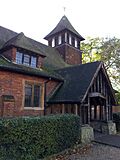 |
Cemeteries and Crematorium
Mortlake Crematorium and two cemeteries, North Sheen Cemetery and Mortlake Cemetery, are located in Kew. The crematorium serves several London boroughs, and the cemeteries are managed by Hammersmith and Fulham Council.
See also
 In Spanish: Kew para niños
In Spanish: Kew para niños



